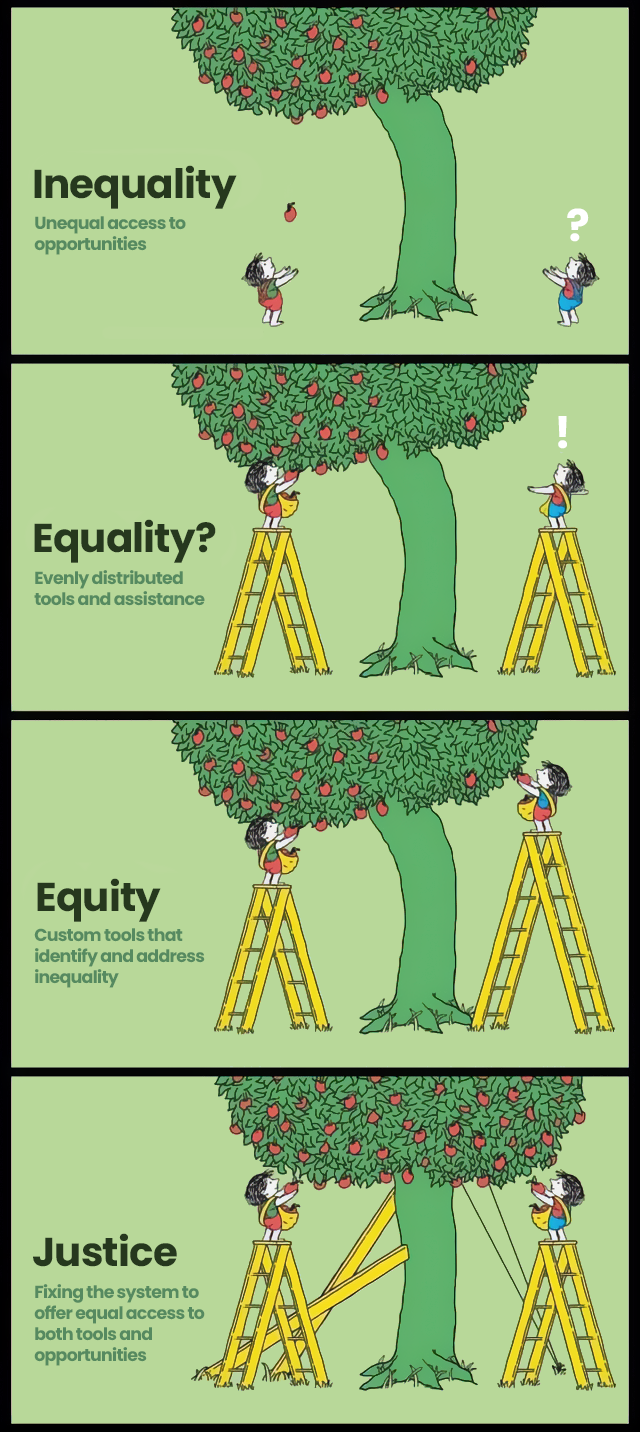Terms Used by J R McKenzie Trust
Equity and social justice
Equity describes when people have the same chance of a high quality of life. This is achieved by making sure that those who experience unfair conditions have access to better tools or supports to overcome them. This helps to bridge the gap with other people who don’t experience the same unfair conditions.
Social justice is similar to equity. In this case, equity is achieved changing the systems that create these unfair conditions so that they don’t exist anymore. This means that everyone could have equal access to the same tools and supports and still experience the same quality of life, because there are no other barriers in the way.
To describe what equity and social justice mean to JR McKenzie Trust, it is helpful to first describes what inequality means.
Inequality describes differences or imbalances in aspects of a people’s quality of life or access to opportunities. This means that some people experience a better quality of life than others.
Equality is sometimes described as the solution to inequality. Equality is when people have access to the same supports or tools as others. However, there may be other factors that mean everyone still doesn’t have the same quality of life or opportunities.
Inequity accounts for these other factors. It recognises that people don’t always have the same chance for a high quality of life even though they might have access to the same tools or supports. This is because of other unfair conditions* in society, like racism or bias, that put some people at a disadvantage (*see above for definition of conditions).
Equity describes when people have the same chance of a high quality of life. This is achieved by making sure that those who experience unfair conditions have access to better tools or supports to overcome them. This helps to bridge the gap with other people who don’t experience the same unfair conditions.
Social justice is similar to equity. In this case, equity is achieved changing the systems that create these unfair conditions so that they don’t exist anymore. This means that everyone could have equal access to the same tools and supports and still experience the same quality of life, because there are no other barriers in the way. This is JR McKenzie’s ultimate goal, because it protects the quality of life of future generations.
Self-determining communities
This is about your community making the decisions and taking the action that works for you.
Self-determining communities are communities that have control over their own choices and resources. Community members are actively leading decision-making about the things that affect them – both now and in the future.
Self-determination relates to the concepts of tino rangatiratanga and mana motuhake in Te Ao Māori.
IN SIMPLE TERMS
This is about your community making the decisions and taking the action that works for you.
Systems-focused solutions; systemic thinking; systems change
Systems thinking is about getting to the roots of what is not working in your community – and what is – to understand what causes problems and to find solutions.
Systemic thinking and solutions refer to ways of thinking and working that have potential to solve a chronic or long-term issue that is experienced by a whole community or population.
It’s about getting to the root cause of the issue by thinking about it as if it were a system or machine – looking at all the moving parts and finding the key ones that need be improved in order to make things work better.
In communities, systemic thinking means looking at what isn’t working well for people and what the causes of this might be; as well as looking at what does work well for people and therefore what the solutions could be.
IN SIMPLE TERMS
Systems thinking is about getting to the roots of what is not working in your community – and what is – to understand what causes problems and to find solutions.

